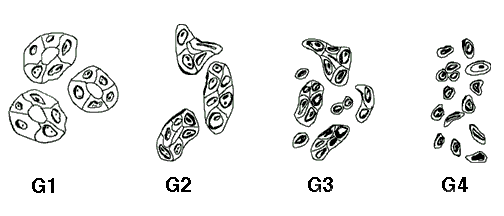

肿瘤分级
肿瘤分级是对恶性肿瘤(主要是癌)而言的,通过显微镜观察HE染色切片可进行区别。一般来说,更高的分级说明肿瘤细胞分化较好,与起源组织更相似,生物学行为更好。常用的分级法为三级法或四级法。
Grading(肿瘤分级)
Grading schema are based upon the microscopic appearance of a neoplasm with H&E staining. In general, a higher grade means that there is a lesser degree of differentiation and the worse the biologic behavior of a malignant neoplasm will be. A well-differentiated neoplasm is composed of cells that closely resemble the cell of origin, while poorly differentiated neoplasms have cells that are difficult to recognize as to their cell of origin. Grading schema have been devised for many types of neoplasms, mainly carcinomas. Most grading systems have three or four grades (designated with numbers or roman numerals).
In the diagram below utilizing an adenocarcinoma as an example, the principles of grading are illustrated:
| Grading of Malignant Neoplasms | |
|---|---|
| Grade | Definition |
| I | Well differentiated (高分化) |
| II | Moderately differentiated 中度分化 |
| III | Poorly differentiated 低度分化 |
| IV | Nearly anaplastic 未分化 |